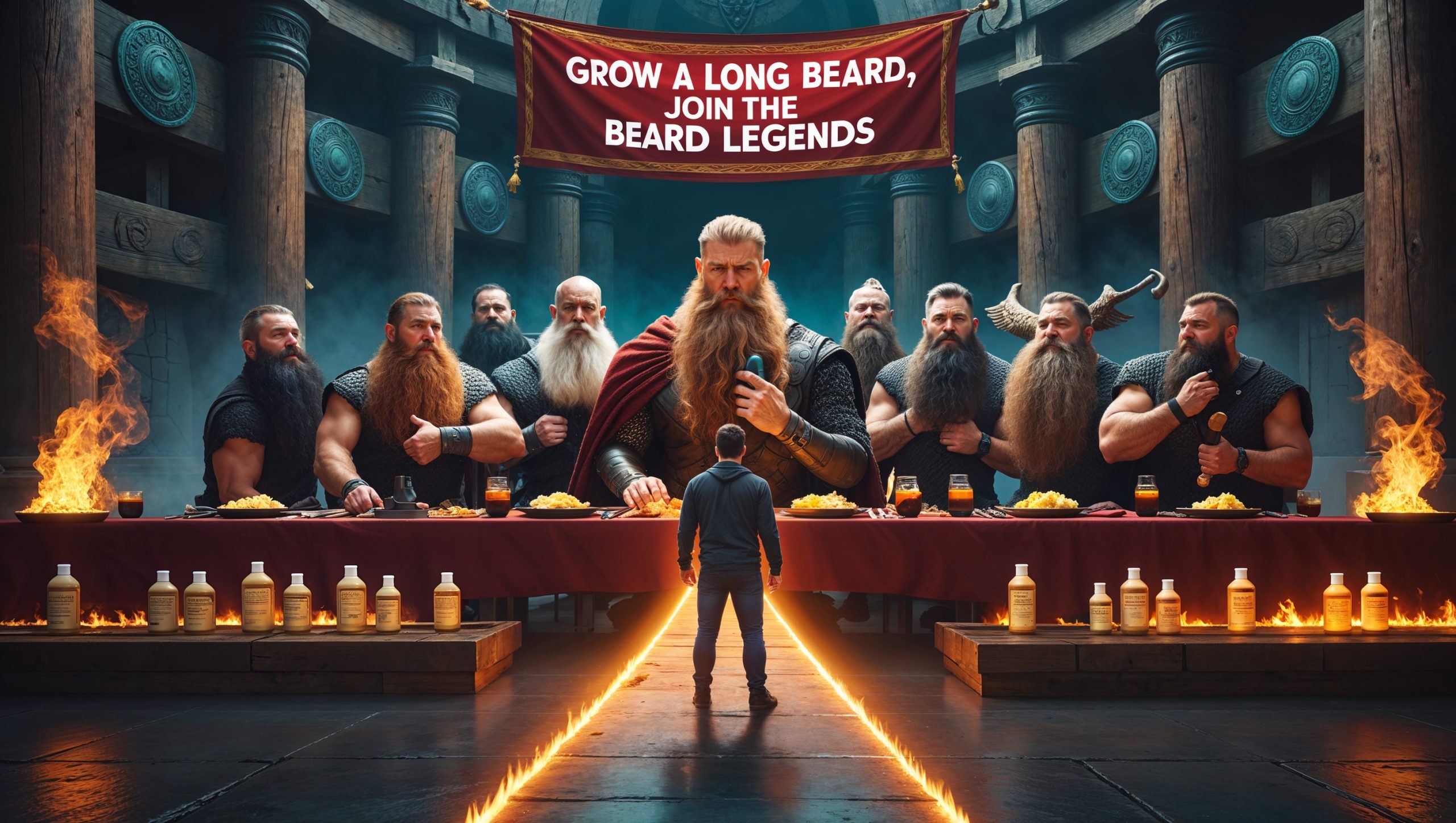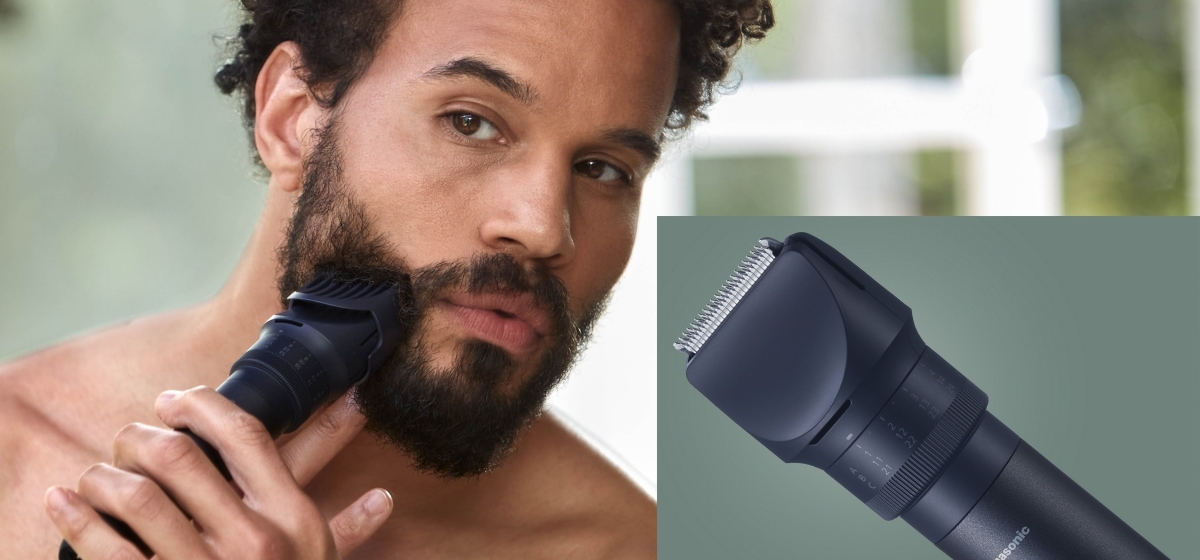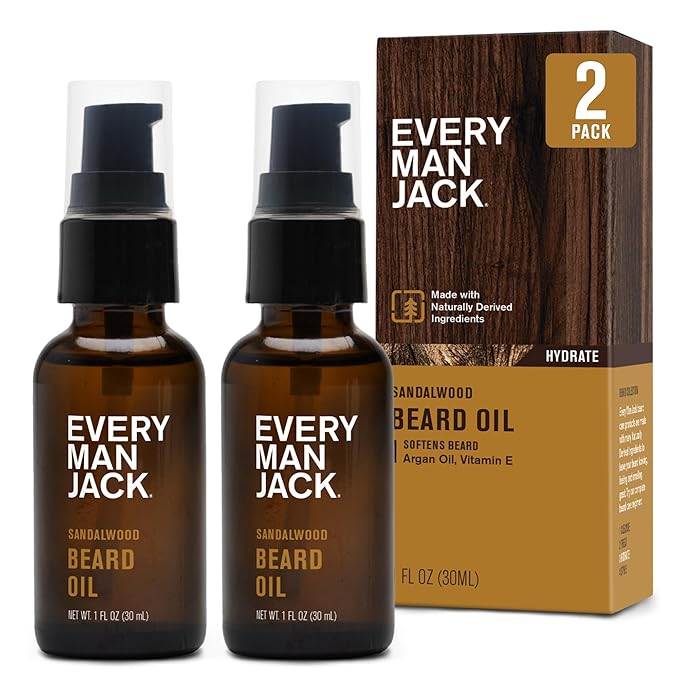Let’s face it (pun absolutely intended): growing a beard isn’t just about looking like a lumberjack who moonlights as a craft beer influencer. For countless men across North America, that journey from clean-shaven to full-blown face forest has become something far more profound—a hairy reflection of their mental health journey.

Who knew that the simple act of putting down the razor could actually pick up your spirits? Turns out, there’s a fascinating connection between what’s growing on your face and what’s happening inside your head. It’s like your facial hair is the world’s slowest progress bar for personal development.
Scientists are starting to stroke their own scholarly beards about this phenomenon too. Research suggests that the discipline required for growing and maintaining facial hair activates the same brain regions involved in other healthy habits. Meanwhile, therapists report that many clients find unexpected parallels between navigating the awkward stubble stage and pushing through difficult emotional growth. It’s not just anecdotal either—studies show that grooming rituals can significantly reduce cortisol (that pesky stress hormone that makes you want to scream into your pillow).
Whether you’re sporting a five o’clock shadow or rocking a beard that could house small woodland creatures, this journey from bare-faced to beardiful often mirrors something deeper. The patience required for that first patchy month, the commitment to push through the itchy phases, the eventual pride in what you’ve cultivated—sound familiar to anyone who’s ever worked on their mental health?
This isn’t about claiming your beard has magical powers (though we won’t rule it out entirely). Rather, it’s about recognizing that sometimes, the most meaningful transformations start with something as simple as letting nature take its course—both on your face and in your mind.
So grab your beard oil and your journal, gentlemen. We’re about to explore how that magnificent mane on your mug might just be teaching you more about mental wellness than any self-help book on your nightstand.
Section 1: The Decision to Grow – Starting Your Beard/Mental Health Journey
Let’s talk about that pivotal moment when you decide to ditch the daily face scraping ritual and let nature do its thing. It’s rarely just about being too lazy to shave (though hey, we’ve all been there after a Netflix binge weekend).
For many guys, growing a beard marks something bigger: a breakup that needed a fresh start, a career pivot that called for a new look, or maybe just a middle finger to the corporate dress code after years of baby-faced compliance. Psychologists call this “enclothed cognition” – how changes to your appearance can fundamentally shift your self-perception. I call it the “face mullet effect”: business as usual up top, party on the lower half.
The Psychology Behind Your Face Fuzz
Science backs this up, fellas. When researchers at the University of Queensland studied men’s motivations for growing beards, they found that major life transitions often trigger the urge to sprout some face fur. It’s like your subconscious saying, “New chapter? New face!” Your beard becomes the physical manifestation of internal change – a hairy mood ring, if you will.
But here’s where things get interesting on the growth front: Can you actually stimulate that beard to grow faster when you’re itching for change? The short answer: kind of, but not in the way most beard growth snake oil salesmen want you to believe.
Despite what that YouTube ad with the suspiciously bearded 19-year-old claims, there’s no magic potion that transforms peach fuzz into a Viking mane overnight. What DOES work? Primarily three things: genetics (thanks or no thanks, Dad), hormones (specifically DHT, dihydrotestosterone), and time (the ingredient nobody wants to hear about). Some supplements like biotin can help strengthen existing hair, and maintaining overall health with proper nutrition definitely supports what your follicles are naturally capable of – but no cream is going to suddenly activate dormant follicles that weren’t planning to join the party.
Mental Health Parallel: Taking That First Step
Notice something? The honest approach to beard growth – accepting what you’re working with, making healthy choices, and having patience – mirrors exactly what therapists recommend for mental health journeys. You can’t rush either process. Both require you to work with what you’ve got while making consistent small improvements.
Just like therapy isn’t an overnight fix, your beard won’t reach Gandalf status by tomorrow. And that’s perfectly fine. The decision to start is what matters most – putting down the razor is your bearded equivalent of picking up the phone to make that first therapy appointment.
Your Beard Origin Story: Time for some reflection, gents. Grab your journal (or Notes app, we won’t judge):
- What was happening in your life when you decided to grow your beard?
- What were you hoping would change – beyond just your appearance?
- How did you feel during those first few days of not shaving?
- Did anyone react positively or negatively to your decision? How did that affect you?
- What similarities do you notice between how you approach beard growing and how you handle other challenges in life?
Remember: Whether your genetic lottery ticket has you destined for a luscious wizard mane or something more… let’s say “minimalist,” the journey itself is where the magic happens. And just like therapy, sometimes the patches and uneven spots tell the most interesting stories.
Up next, we’ll tackle the notorious awkward phase – that special time when your face looks like it’s apologizing for itself, and why pushing through it might be the best thing you’ll do for your mental game this year.
Section 2: The Awkward Phase – Embracing Discomfort
Ah, the awkward beard phase – that special time when you look less “distinguished gentleman” and more “forgot to do laundry for three weeks.” Welcome to beard purgatory, gentlemen. Your face is itchy, your significant other is giving you side-eye, and your mom keeps asking if you’re “going through something.”
This, my patchy-faced friends, is where beard boys become beard men.

The 4-Week Beard Rule: Your Hairy Trial By Fire
Ever wonder why so many guys bail around week two? Because they never heard about the sacred “4-Week Beard Rule” – the bearded community’s version of “this too shall pass.”
The 4-Week Beard Rule isn’t just beard bro science; it’s a legitimate psychological milestone. Your follicles need about a month to establish their territory and start cooperating with each other. During these crucial 28 days, your beard is essentially a rebellious teenager – awkward, unpredictable, and constantly testing your patience. Some hairs grow faster than others, some grow in different directions, and some spots might look like they missed the memo entirely.
Psychologically speaking, this is the perfect storm of discomfort: you’re physically itchy, visually underwhelmed, and socially questionable. Sound familiar to anyone who’s started therapy? That’s because both journeys share the same uncomfortable middle where you’re no longer who you were but not yet who you’re becoming.
The Touching Question: Hands Off Or Hands On?
Now for the million-dollar question: “Does touching your beard help it grow?” I can almost hear the collective beard-stroking intensify.
Here’s the fuzzy truth: No, fondling your face forest doesn’t magically make it fuller. In fact, excessive touching can introduce oils and dirt that clog follicles. BUT – and this is where it gets interesting – gentle massage increases blood circulation to hair follicles, which can support healthier growth of existing hairs.
Think of it like watering plants – you’re not creating new plants, but you’re helping the existing ones thrive. Just wash your hands first, ya filthy animal. Your beard is collecting enough crumbs on its own without your keyboard-grubby fingers adding to the party.
Mental Health Parallel: The Therapeutic Itch
This awkward phase mirrors exactly what happens in therapy around sessions 3-7. The initial excitement wears off, the discomfort sets in, and you start wondering if this whole “growth” thing is worth it. Therapists call this “resistance” – that moment when your brain realizes change is actually happening and freaks the beard out.
Just like your patchy facial situation, emotional growth isn’t linear or pretty at first. You’ll have days when your anxiety is well-behaved and days when it’s running around your brain like a toddler with scissors. The key isn’t avoiding the awkward; it’s making peace with it.
Remember: your beard isn’t growing wrong; it’s just growing. Same goes for your mental health.
Discomfort Journal: For the next week, try this dual-tracking exercise:
- Take a weekly beard progress pic (same lighting, same angle)
- Next to it, rate your comfort level with your beard (1-10)
- Then note one thing you’re uncomfortable with in your personal growth journey
- At the end of the week, look for patterns. Does your beard comfort correlate with other comfort zones?
Example:
Monday: Beard still patchy on right cheek (3/10). Also avoiding that conversation with my boss (coincidence? I think not).
Thursday: Mustache connecting to beard better today (5/10). Actually sent that difficult email I've been putting off.
So when your co-worker points out that your beard “still looks a bit sparse there, bud,” just stroke your patchy masterpiece and reply, “It’s not sparse, it’s selective. Like my emotional availability.” Then wink mysteriously and walk away. Power move.
Up next: how turning your random beard growth into a proper routine might just revolutionize more than your face game. Spoiler alert: we’re getting into the derma roller debate, and things might get prickly!
Section 3: Establishing Routine – The Power of Small Habits
Remember when “self-care” meant ordering the large fries instead of medium? Well, gents, welcome to the next level: intentional beard maintenance as a form of mindfulness. It’s like yoga, but with less embarrassing pants and more sandalwood scent.
The Beard Massage Mystery: Rubbing Your Way to Glory?
Let’s tackle the burning question: “Does massaging your beard help it grow?” While your beard isn’t exactly a Chia Pet that sprouts with the right touch, there’s actually some science behind this one.
Massaging stimulates blood circulation to your follicles, delivering more nutrients and oxygen to those hungry hair roots. It’s like UberEats for your face fibers. A 2016 study in the Journal of Dermatology actually found that regular scalp massage increased hair thickness – and while your face isn’t your scalp, the underlying mechanism is similar.
The proper technique matters though. Use your fingertips (not nails, Edward Scissorhands) to make gentle circular motions, working from neck to cheeks for about 2-3 minutes daily. Bonus points if you incorporate this with beard oil application, creating what I call the “Double Whammy” – conditioning AND circulation in one glorious ritual.
The Derma Roller Debate: Tiny Needles, Big Questions
Nothing says “I’m committed to my beard” quite like rolling hundreds of tiny needles across your face. Welcome to the wild world of derma rolling.
“Do derma rollers actually help beard growth?” and “Do they actually work?” are essentially asking the same question, and the answer is: yes, with caveats. Microneedling creates controlled micro-injuries that stimulate collagen production and can enhance product absorption. Studies show it can improve hair growth – particularly when combined with minoxidil (though we’re focusing on natural approaches here).
Now for the question everyone’s too manly to ask but secretly wonders: “Is the derma roller painful?” Let’s just say it’s more “spicy tingle” than “medieval torture.” With proper technique and the right needle length (0.5mm is the sweet spot for beards), it should feel like a mild prickly sensation. If it feels like you’re auditioning for a horror movie, you’re pressing too hard, tough guy.
The catch? Consistency and cleanliness. If you’re going to make tiny holes in your face, maybe don’t do it with something you found under your car seat. Sterilize that roller before each use, and stick to a twice-weekly schedule. More isn’t better – your face needs recovery time, just like your dignity after karaoke night.
Mental Health Parallel: The Ritual of Self-Respect
Here’s where beard care gets surprisingly deep: establishing a consistent grooming routine isn’t just about vanity; it’s a physical manifestation of self-respect. When you dedicate those five minutes every morning to proper beard care, you’re telling yourself, “I’m worth this time and attention.”
Psychologists call these “keystone habits” – practices that trigger positive chain reactions in other aspects of life. The guy who takes time to condition his beard properly is often the same guy who starts making his bed, drinking more water, or finally telling Dave from accounting that, no, he can’t “just quickly look at something” during lunch break.
For men struggling with depression or anxiety, these small, consistent acts of self-care become powerful anchors in chaotic emotional seas. They’re tangible reminders that even when you can’t control everything, you can control how you treat yourself – face fur included.
My Daily Beard/Mind Ritual:
Take 5 minutes to design your perfect beard/mental wellness routine:
- Morning: [Example: 30-second beard rinse with cool water + oil application while saying one thing I’m looking forward to today]
- Mid-day: [Example: Quick beard check/touch-up + 3 deep breaths]
- Evening: [Example: Beard wash and condition + one-minute reflection on what went well today]
- Weekly Special: [Example: Sunday night derma rolling session while listening to my favorite podcast]
Remember: The most effective beard routine isn’t necessarily the most complex – it’s the one you’ll actually do consistently. Just like therapy homework that never gets done, that $65 artisanal beard balm made by Norwegian elves isn’t helping anyone sitting unused in your drawer.
Next up: why the three-month mark might be both a beard milestone and mental breakthrough waiting to happen. Spoiler: it involves the word “terminal,” but in a good way. (Mostly.)
Section 4: The Commitment Phase – Getting Through Plateaus
The Mythical Three-Month Mark
Ah, the three-month beard milestone—or as I like to call it, “The Point Where Your Face Finally Stops Looking Like It’s Apologizing.” The legendary “3-Month Beard Rule” isn’t just some arbitrary checkpoint invented by Big Beard to sell more balm. It’s actually the magical moment when most men can finally assess what they’re really working with.
Here’s the hairy science: Around 90-100 days, your beard reaches what the follically obsessed call “terminal length” for the first growth phase. Translation? Your early-blooming follicles have hit their stride, the slow pokes have (mostly) caught up, and you can finally see your beard’s true personality. It’s like your facial hair’s coming-out party, minus the awkward tuxedo photos.
This is also when many beardsmen hit their first real plateau—that frustrating period where it seems like your face forest has signed a non-growth agreement. Your mirror sessions start to include squinty-eyed examinations and the age-old question: “Is it actually getting thicker or am I just getting more attached to it?”
Do Beard Stimulators Actually Work? The Wallet-Thinning Truth
Let’s address the woolly mammoth in the room: those miracle beard growth potions promising to turn your patchy chin situation into a Leonidas-level face mane. Do beard stimulators actually work, or are they just expensive face moisturizers with aggressive marketing?
The somewhat disappointing truth sandwich (with truth bread on both sides): Most commercial “beard growth” products fall somewhere between “subtle helper” and “placebo in a fancy bottle.” The science simply doesn’t support the dramatic before-and-after photos that probably involved different lighting, angles, and possibly someone’s much hairier cousin.
What CAN make a difference?
- Minoxidil (yes, the stuff for balding heads) has actual research backing its effectiveness for beards
- Products with caffeine can temporarily stimulate follicles
- Supplements like biotin and vitamin D might help if you’re deficient
What’s basically expensive face lotion?
- Anything promising “2 inches in 2 weeks!”
- Products with “proprietary beard growth complex” (which usually translates to “we added peppermint oil and a prayer”)
- Anything endorsed exclusively by men who look genetically engineered to grow beards on their beards
The psychological aspect here perfectly mirrors therapy plateaus: just when you’re making real progress, it feels like you’ve stalled. And just like therapy, this is exactly when snake oil solutions seem most tempting.
Derma Rolling Revisited: Needling Your Way Through the Plateau
“Do derma rollers actually help beard growth?” is the beard world’s equivalent of asking if that expensive pillow really improves your sleep. The answer? Yes, but probably not as dramatically as TikTok would have you believe.
The science is legitimately promising here: microneedling increases blood flow and collagen production while creating channels for better product absorption. Multiple studies show improved hair growth with consistent use. The catch? Results vary wildly based on your genetic potential. It’s giving your existing follicles a pep talk, not creating new ones from scratch.
For plateau-busting results:
- Use the right needle length (0.5mm for beard areas)
- Roll in multiple directions (up/down, side/side, diagonal)
- Apply beard oil or growth serum AFTER rolling (not before—ouch!)
- Stick to twice weekly sessions (more isn’t better, beard Wolverine)
Mental Health Parallel: The Therapeutic Middle Ground
This phase mirrors exactly what happens around month three of therapy or meditation practice. The initial excitement fades, progress seems less obvious, and you start wondering if you’ve gotten all you’re going to get from this journey.
Therapists call this the “working through” phase—that crucial middle ground where the real transformation happens, even when it’s less visible. Like your beard growth, the changes are happening beneath the surface, strengthening roots and establishing patterns that will eventually show.
This is where commitment becomes more important than motivation. On days when you don’t feel like applying your beard oil or doing your mental health exercises, those are precisely the days they matter most.
Plateau Breakers:
When your beard or mental health progress seems stalled, try these reset activities:
- The Photo Evidence: Find your earliest beard picture and compare it to today. Progress is often invisible day-to-day but obvious over time. (Works for mental health journaling too!)
- The Routine Shake-up: Try a new beard oil scent or grooming technique. For mental health, take your meditation or journaling to a completely new location.
- The Expert Consult: Book a session with a professional barber for shape advice. Mental health equivalent: check in with your therapist about adjusting your approach.
- The Community Connect: Find a beard group online or—radical idea—talk to another bearded guy in real life. Mental health version: share one struggle with a trusted friend.
Remember, fellas—plateaus aren’t failures; they’re just the universe’s way of testing if you’re serious about this whole beard/personal growth thing. The best beard in the room isn’t the longest or fullest; it’s the one that was patiently cultivated through the awkward stages. Kind of like the best mental health isn’t about never struggling, but about having the tools to work through the patches.
Next up: finding your beard tribe and why that “Rule of 5” might be the secret sauce your face forest (and mental landscape) has been missing.
Section 5: Identity and Community – Finding Your Beard Tribe
When your beard reaches respectable proportions, something magical happens: you start nodding at other bearded guys like you’re both members of a secret society. And guess what? You kind of are.
The Beard Brotherhood: More Than Just Face Carpets
Your beard isn’t just hair—it’s a hairy bat signal to like-minded individuals. Studies show that men with beards often rate other bearded men as more trustworthy and capable. It’s like being in the world’s fuzziest club where the only membership requirement is putting down the razor.
This sense of belonging isn’t just beard fantasy—it’s powerful psychology. Finding your “beard tribe” provides the same community benefits that therapists have been preaching about for years: decreased isolation, shared experience, and the comfort of knowing someone else understands the struggle of eating soup without creating a botanical garden in your facial foliage.
The Rule of 5: Your Beard’s Golden Ratio
Now for the mystical “Rule 5 for beards” that beard sages whisper about. While it sounds like something from an ancient scroll, it’s actually pretty straightforward: the best beard maintenance happens in multiples of 5.
The Rule of 5 breaks down like this:
- Wash thoroughly every 5 days (daily washing strips natural oils)
- Apply beard oil at least 5 minutes before styling
- When trimming, never take more than 5mm at once
- Use 5 “beard care minutes” daily (oil, combing, etc.)
- Review your beard style every 5 months
This 5-based approach creates balance between maintenance and obsession—exactly what mental health professionals recommend for healthy habit formation. Consistency without rigidity is the sweet spot for both your chin curtain and your cranium.
Conclusion: The Bearded Mind – Growing More Than Just Hair
What started as a decision to skip shaving has likely become something more meaningful on your journey. Your beard—whether it’s a modest scruff or full-blown wizard status—has been a living timeline of your personal growth.
The patience you learned during the patchy phase, the routine you established during plateaus, and the community you found along the way—these aren’t just beard lessons. They’re life lessons with the convenient bonus of looking ruggedly handsome.
Remember:
- Growth takes time—both the facial and personal kinds
- Consistency beats intensity every time
- The most valuable tools aren’t necessarily the most expensive
- Your beard, like your mental health, is uniquely yours—embrace its quirks
Whether you’re sporting the beard of your dreams or still working through some patchy areas (on your face or in your life), the journey itself is where the magic happens. Keep growing, keep grooming, and keep going—your best beard, like your best self, is always evolving.





There’s something mesmerizing in the way you bring clarity to complex concepts, making them feel like second nature.
Thankyou. Thats nice to know